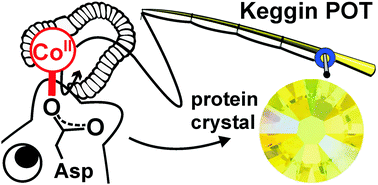Transition metal-substituted Keggin polyoxotungstates enabling covalent attachment to proteinase K upon co-crystallization†
Abstract
The use of α- and β-Keggin polyoxotungstates (POTs) substituted by a single first row transition metal ion (CoII, NiII, CuII, ZnII) as superchaotropic crystallization additives led to covalent and non-covalent interactions with protein side-chains of proteinase K. Two major Keggin POT binding sites in proteinase K were identified, both stabilizing the orientation of the substituted metal site towards the protein surface and suggesting increased protein affinity for the substitution sites. The formation of all observed covalent bonds involves the same aspartate carboxylate, taking the role of a terminal oxygen with the Keggin α-isomer or even, in an unprecedented scenario, a bridging cluster oxygen with the β-isomer. Covalent bond formation with the protein carboxylate was observed only with the NiII- and CoII-substituted POTs, following the HSAB concept and the principle of metal immobilization.



 Please wait while we load your content...
Please wait while we load your content...